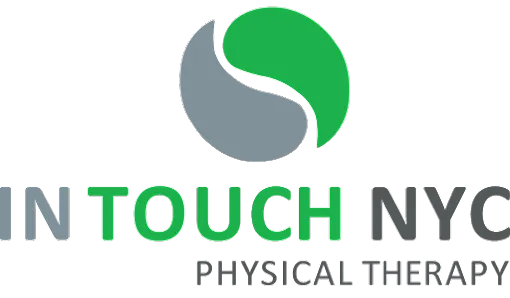Pelvic Floor Therapy In Manhattan

Interested in pelvic floor therapy services at In Touch Physical Therapy? Our expert pelvic floor therapist, Beth Simoes, specializes in women-focused pelvic issues and is dedicated to serving her female patients.
Pelvic floor physical therapy addresses pain, weakness, or dysfunction in the pelvic floor muscles. These muscles function well and allow blood to flow to connective tissue and muscle tissue. This improves mobility.
Pelvic floor physical therapy aims to restore mobility, movement, and health. We will identify trigger points in the muscles and tight connective tissue that could be causing pain or discomfort.
For decades, doctors have considered physical therapy as an effective and non-invasive way to treat pelvic floor dysfunction. Our physical therapists use a range of non-invasive, painless methods to retrain pelvic floor muscles. This helps control bladder, bowel, and sexual function. The ability to relax and strengthen the pelvic floor muscles can improve function, as well as reduce any discomfort or pain you might have felt.
We will teach you exercises to strengthen and stabilize your core during pelvic floor therapy. This includes the major muscles that stabilize the trunk (including the abdominal, back, and diaphragm). You will also need to retrain and strengthen your pelvic floor muscles.
Your therapist will identify which muscles are tight and show you how to stretch them to increase mobility and coordination. You will also learn relaxation techniques and postural exercises that can help improve your symptoms.
importance of Women-Focused Pelvic Floor Therapy in Manhattan
The pelvic floor is made up of a layer that extends from the pubic bone to your tailbone. The bladder, bowel, and vagina are supported by the pelvic floor muscles and connective tissues in women.
Women have pelvic floor muscles that control their bladder and bowel functions. They also play a role in sexual function and pleasure. Pregnant women’s pelvic floor muscles support the fetus and must relax during natural birth.
The pelvic floor muscles contract and relax to control bladder and bowel functions. To prevent incontinence, the pelvic floor muscles must contract and then relax to allow for bowel movements and urination. When the muscles contract too strongly or too slowly, individuals can experience incontinence, constipation, and pain during intercourse. Trauma to the pelvic floor can cause pain and dysfunction after childbirth, surgery, certain medical procedures, or a history of physical abuse.
Pelvic Floor Dysfunction: What Are the Symptoms?
Pelvic Floor Dysfunction could be caused by one or more of these symptoms. Talk to your doctor if you experience any of the following symptoms.
- You may need to frequently use the bathroom. Sometimes you may feel like you have to force it or stop and start so many times.
- Constipation, or a straining pain during your bowel movements. A pelvic floor dysfunction may be the reason for up to half of those suffering from long-term constipation.
- Pushing hard or straining to get a bowel movement. It is possible to find yourself changing your position on the toilet or even using your hand for stool elimination.
- Incontinence (leaking stool or urine)
- Urination that is frequent or painful
- Feeling pain down your lower back?
- Constant pain in the pelvic region, genitals, or rectum You may feel pain with or without a bowel movement.
There are some symptoms and conditions that can be caused by pelvic floor dysfunction in women.
Pelvic dysfunction can affect reproductive health and cause pain during sexual intercourse.
Stress urinary incontinence, or leakage of urine during coughing, laughing or sneezing can affect women with pelvic dysfunction. SUI is more common in women, with 35% of women suffering from it during their lifetime.
What causes Pelvic Floor Dysfunction?
Experts believe that pelvic floor dysfunction may be caused by one or more of these conditions.
- During long labor, strain on tissues and muscles during birth
- Vaginal birth
- Interstitial cystitis, also known as “painful bladder Syndrome”
- Obesity
- Traumatic injuries to your pelvic area due to a car accident
- Surgery of the pelvic floor
- Nerve damage
- Chronic coughing
- Constipation is a chronic condition.
- Weightlifting
- Running is a high-impact activity.
- Excessive use of the pelvic muscles (frequent urination, bowel movements, or straining)
- Menopause and aging
What to Expect at Your First Session of Pelvic Floor Therapy in Manhattan?
We know that pelvic floor dysfunction can have a personal impact on you and that you might be anxious or afraid about what to expect. Our physical therapists have years of experience in working with pelvic issues and are compassionate professionals. They will answer all of your questions and thoroughly explain each step.
Your physical therapist will conduct a thorough assessment at your first visit to determine the best treatment plan.
The goal of pelvic floor physical therapy is to improve mobility, and movement, and reduce pain. The therapist will evaluate your posture, breathing patterns, strength, flexibility, and mobility of your spine, hips, and abdomen to identify contributing factors.
Our goal is to determine the cause of pelvic floor dysfunction. We can diagnose the problem faster if we have more details about your symptoms. Bring detailed notes on your symptoms to the session, including any pain that is worsening or relieving.
Your therapist might ask you to move around during your visit to evaluate certain functions. Wear comfortable clothes. We encourage you to ask questions and give feedback during each visit.
The following are the results of our initial assessment:
- A thorough review of your medical history
- An in-depth evaluation of your symptoms
- A thorough evaluation of tight, painful or dysfunctional areas
- Complete physical exam
We will ask you to stand, sit, and walk during the exam in order to identify any potential joint or posture issues that could be affecting your pelvic floor muscles. Also, we will assess if there are any bone or muscle issues in your lower back or hips, sacroiliac joints, buttocks or thighs that could be causing pain or dysfunction to your pelvic floor muscles.
A physical exam will be performed by your physical therapist. This may include an internal examination in some cases. Our therapists have been trained in the treatment of pelvic floor dysfunction. Because we understand that you might feel uncomfortable during the examination, we take each step carefully and purposefully. This upfront effort can help you identify muscle and strength-related problems that may be causing your discomfort.
Your physical therapist will take it slow and explain each step. Ask questions. You can pause the exam at any time.
Benefits of Pelvic Floor Therapy
Patients will often want to weigh the benefits and drawbacks of the service before they choose a rehab program. Our team understands the benefits of pelvic floor physical therapy for patients. We hope that you will consider this option if you find the problems you face becoming too difficult to manage. You can expect to reap many benefits after reaching out to us and beginning your sessions of treatment.
- Lower pain levels.
- Greater range of motion.
- Increased sexual function.
- Reduced risk of chronic pain.
- Corrected bowel and urinary patterns.
You can help with your own recovery
You can do a lot to help your recovery. These self-care tips will help you not only get your pelvic floor dysfunction under control but also improve your physical and mental health.
- Your physical therapist may recommend that you do home exercises.
- If recommended, you should perform Kegel exercises regularly.
- When you urinate or have a bowel movement, avoid pushing or straining.
- A healthy lifestyle includes good nutrition, adequate water intake, regular exercise, healthy eating habits, healthy sleep patterns, healthy sleeping schedules, healthy food choices, healthy weight loss, healthy stress management, healthy relaxation techniques, and positive thinking. Warm baths can help relax muscles and increase blood circulation.
- Your physical therapist may recommend regular home use of certain devices, such as an electrical stimulator, biofeedback device, dilator, or vaginal cones.
- Your physical therapist will teach you how to self-massage.
Anxiety-provoking topics like pelvic floor problems can cause anxiety. Do not let shame or stigma prevent you from seeking the treatment you need to have a happy life. We strive to provide a welcoming and safe environment for you to receive non-judgmental treatment. We are able to facilitate difficult and stressful conversations with loved ones and family members who may be able to help you in your recovery and care.
**Disclaimer: Our pelvic floor therapist will only treat women for this service.


